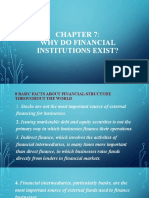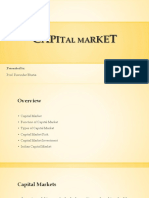Commercial Bank Operations
Commercial Bank Operations
Uploaded by
Pradnyesh GanuCopyright:
Available Formats
Commercial Bank Operations
Commercial Bank Operations
Uploaded by
Pradnyesh GanuCopyright
Available Formats
Share this document
Did you find this document useful?
Is this content inappropriate?
Copyright:
Available Formats
Commercial Bank Operations
Commercial Bank Operations
Uploaded by
Pradnyesh GanuCopyright:
Available Formats
Commercial Bank Operations
Chapter Objectives
Describe the most common sources of funds for commercial banks Describe the most common uses of funds for commercial banks Describe typical off-balance sheet activities for commercial banks
Bank Participation in Financial Conglomerates
Impact of the Financial Services Modernization Act (1999)
Banks and other financial service firms were given more freedom to merge and offer a range of financial services
Insurance Securities services
Banks now a subsidiary of financial conglomerates
3
Bank Participation in Financial Conglomerates
Benefits of diversified services to individuals and firms
Individuals can obtain all their financial services at a single financial conglomerate
Deposits Loans Investing Insurance
(brokerage)
Businesses can obtain loans, issue stocks and bonds, and have their pension fund managed by the same institution
4
Bank Participation in Financial Conglomerates
Benefits of diversified services to the financial institution
Reduce reliance on demand for single service Economies of scale and scope Diversification (service and geographical) may result in less risk Generate new business
Bank Sources of Funds
Transaction deposits
Demand deposit account (checking)
Savings Deposits
Passbook savings
Bank Sources of Funds
Time Deposits
Certificate of deposit (CD)
No
secondary market
Negotiable CD
Short-term,
minimum $100,000 Can trade among investors via dealer
Money Market Deposit Accounts (MMDAs)
More liquid than CDs : no specified maturity Limited check writing Created in 1982
Bank Sources of Funds
Federal Funds Purchased
Short-term loans between banks Allows banks to meet reserve requirement or funding needs Interest rate charged is the federal funds rate Borrowing at the discount window Discount rate Intended for meeting temporary short-term reserve requirement needs Must get Fed approval
8
Borrowing from the Federal Reserve Banks
Bank Sources of Funds
Repurchase agreements
Sale of securities by one party to another with an agreement to repurchase the securities at a specified date and price Banks may sell T-bills to a corporation with temporary excess cash (bank demand deposit) and then buy them back later Source of funds for a few days Collateralized by the treasury bills
9
Bank Sources of Funds
Eurodollar borrowings
Banks outside the United States make dollardenominated loans Eurodollar market is very large Like other businesses, banks issue bonds to finance long-term fixed assets Usually subordinated to deposits Part of secondary regulatory capital
Bonds issued by the bank
10
Bank Sources of Funds
Bank capital
Obtained from issuing stock or retaining earnings No obligation to pay out funds in the future Must be sufficient to absorb operating losses
11
Uses of Funds by Banks
Loans make up about 64 percent of bank assets, while all securities make up about 22 percent of assets. Cash represents 6 percent of bank assets. Cash and due from balances at institutions
Currency/coin provided via banks Reserve requirements imposed by Fed
Tool
for controlling the money supply Due from Fed and vault cash count as reserves
Also hold cash and due from balances to maintain liquidity and accommodate withdrawal requests by depositors
12
Uses of Funds by Banks
Bank Loans
Types of business loans
Working capital loans Term loans
Purchasing fixed assets Protective covenants
Informal line of credit Revolving credit loan
13
Uses of Funds by Banks
Bank Loans
Loan participations
Sometimes
large firms seek to borrow more money than an individual bank can provide Lead bank
Loans supporting leveraged buyouts
Banks
charge a high loan rate Monitored by bank regulators
14
Uses of Funds by Banks
Bank Loans
Collateral requirements on business loans
Increasingly
accepting intangible assets Important to service-oriented firms Increased lending risk with service businesses--telecomm
Types of consumer loans
Installment
loans Credit cards
Real estate loans
15
Uses of Funds by Banks
Investment securities (bank income and liquidity)
Treasury securities Government agency securities
Freddie Mac Fannie Mae Investment grade only
16
Corporate and municipal securities
Federal funds sold
Lending funds in the federal funds market
Uses of Funds by Banks
Repurchase agreements Eurodollar loans
Branches of U.S. banks located outside of the U.S. Foreign-owned banks
Fixed assets
Office buildings Land
17
Off-Balance Sheet Activities
Loan commitments
Obligation of bank to provide a specified loan amount to a particular business upon request Note issuance facility (NIF) Banks earn fee income for risk assumed
Standby letters of credit (SLC)
Backs a customers obligation to a third party Banks earn fee income
18
Off-Balance Sheet Activities
Forward contracts
Agreement between a customer and bank to exchange one currency for another on a particular future date at a specified exchange rate Allows customers to hedge their exchange-rate risk
19
Off-Balance Sheet Activities
Swap contracts
Two parties agree to periodically exchange interest payments on a specified notional amount of principal Banks serve as intermediaries or dealer and/or guarantor for a fee
20
You might also like
- The Clockmaker's DaughterDocument2 pagesThe Clockmaker's DaughterLEGANDARY DIAMOND AminNo ratings yet
- Spaghetti and Meatballs For AllDocument3 pagesSpaghetti and Meatballs For Allapi-295655000No ratings yet
- Asset Allocation 5E (PB): Balancing Financial Risk, Fifth EditionFrom EverandAsset Allocation 5E (PB): Balancing Financial Risk, Fifth EditionRating: 4 out of 5 stars4/5 (13)
- Case Study SVBDocument4 pagesCase Study SVBAnshula KolheNo ratings yet
- Credit and Collection Module 3Document2 pagesCredit and Collection Module 3aivan john CañadillaNo ratings yet
- Delinquency ManagementDocument4 pagesDelinquency ManagementJeff SmithNo ratings yet
- International Cash ManagementDocument52 pagesInternational Cash ManagementPanashe MachekepfuNo ratings yet
- Boundary Layer LabDocument8 pagesBoundary Layer Labchantelle100% (1)
- Chapter-22 - Finance Company OperationsDocument17 pagesChapter-22 - Finance Company Operationsmohammad olickNo ratings yet
- CHAPTER 2 International Commercial BankingDocument38 pagesCHAPTER 2 International Commercial BankingMuhammad Hanif100% (1)
- Capital Markets Chapter 3Document11 pagesCapital Markets Chapter 3Faith FajarilloNo ratings yet
- Types of BanksDocument2 pagesTypes of BanksJeCabaisNo ratings yet
- Core Risks in BankingDocument9 pagesCore Risks in BankingVenkatsubramanian R Iyer100% (1)
- Finance Is The Lifeline of Any BusinessDocument22 pagesFinance Is The Lifeline of Any BusinessmeseretNo ratings yet
- Chattel MortgageDocument9 pagesChattel MortgageLess Balesoro100% (1)
- Commercial BankDocument11 pagesCommercial BankVaibhavi BorhadeNo ratings yet
- Financial InstitutionsDocument76 pagesFinancial InstitutionsGaurav Rathaur100% (1)
- B. Non Bank Financial InstitutionDocument13 pagesB. Non Bank Financial InstitutionErica GallurNo ratings yet
- Credit ManagementDocument75 pagesCredit ManagementYurih Khei Jham AluminumNo ratings yet
- BSA2A WrittenReports Thrift-BanksDocument5 pagesBSA2A WrittenReports Thrift-Banksrobert pilapilNo ratings yet
- WCM - Unit 2 Cash ManagementDocument51 pagesWCM - Unit 2 Cash ManagementkartikNo ratings yet
- Banking Financial Institutions - SyllabusDocument8 pagesBanking Financial Institutions - SyllabusLove RosalunaNo ratings yet
- Loan Syndication: 1. Pre-Signing StageDocument5 pagesLoan Syndication: 1. Pre-Signing StageFarhan Ashraf SaadNo ratings yet
- Stock Valuation - Financial ManagementDocument10 pagesStock Valuation - Financial ManagementNoelia Mc DonaldNo ratings yet
- Introduction of Loan PortfolioDocument2 pagesIntroduction of Loan PortfolioGaurav SharmaNo ratings yet
- Foreign Exchange Risk ManagementDocument12 pagesForeign Exchange Risk ManagementDinesh KumarNo ratings yet
- 07 Multinational Financial ManagementDocument61 pages07 Multinational Financial Managementeunjijung100% (1)
- Financial Institution and MarketDocument52 pagesFinancial Institution and Marketsabit hussenNo ratings yet
- Chapter - Monetary Policy (Model & Transmission) 1Document4 pagesChapter - Monetary Policy (Model & Transmission) 1Nahidul Islam IUNo ratings yet
- Shanghai StoCK ExchangeDocument17 pagesShanghai StoCK ExchangeRachitAroraNo ratings yet
- Source of CapitalDocument10 pagesSource of Capitalrenatus APOLINARYNo ratings yet
- Role of Central BankDocument6 pagesRole of Central BankWajeeha RizwanNo ratings yet
- FM Lecture 9Document28 pagesFM Lecture 9Awan NadiaNo ratings yet
- Edoc - Tips Ch01 Financial Markets Money MarketDocument12 pagesEdoc - Tips Ch01 Financial Markets Money MarketKelvin LeongNo ratings yet
- Eurocurrency Markets and International Banking.2019Document113 pagesEurocurrency Markets and International Banking.2019Nandish KothariNo ratings yet
- Tadifa ReportDocument28 pagesTadifa ReportBennie AmansecNo ratings yet
- Learning Module 4 IpmDocument6 pagesLearning Module 4 IpmAira Abigail100% (1)
- Investment Banking OverviewDocument2 pagesInvestment Banking OverviewJack JacintoNo ratings yet
- Consumer LoansDocument67 pagesConsumer LoansHà ĐoànNo ratings yet
- Chapter 7 Bond MarketsDocument21 pagesChapter 7 Bond MarketsKhánhvy HuỳnhNo ratings yet
- Financial Futures MarketsDocument48 pagesFinancial Futures MarketsAnthony KwoNo ratings yet
- Financial ManagementDocument205 pagesFinancial ManagementdnlkabaNo ratings yet
- A 2 - Roles and Functions of Various Participants in Financial MarketDocument2 pagesA 2 - Roles and Functions of Various Participants in Financial MarketOsheen Singh100% (1)
- Ethical Issue in BusinessDocument6 pagesEthical Issue in BusinessJudil BanastaoNo ratings yet
- Chap-17-Lending Policies and ProceduresDocument30 pagesChap-17-Lending Policies and ProceduresNazmul H. PalashNo ratings yet
- What Is Financial RiskDocument9 pagesWhat Is Financial RiskDeboit BhattacharjeeNo ratings yet
- Chapter 7 Why Do Financial Institutions ExistDocument10 pagesChapter 7 Why Do Financial Institutions ExistJay Ann DomeNo ratings yet
- Capital MarketDocument26 pagesCapital MarkethimanshusangaNo ratings yet
- Chapter 1 Capital MarketsDocument7 pagesChapter 1 Capital MarketssayNo ratings yet
- Financial Market in Pakistan: Financial Markets and Their Roles: Commercial BanksDocument5 pagesFinancial Market in Pakistan: Financial Markets and Their Roles: Commercial BanksAnamMalikNo ratings yet
- Sources of International FinancingDocument6 pagesSources of International FinancingSabha Pathy100% (2)
- Investment BankDocument8 pagesInvestment BankArun KumarNo ratings yet
- Financial SystemDocument7 pagesFinancial SystemsaadsaaidNo ratings yet
- Chapter 4 Commercial BanksDocument33 pagesChapter 4 Commercial BanksChichay KarenJoyNo ratings yet
- Historical Development of The Banking System in The PhilippinesDocument1 pageHistorical Development of The Banking System in The PhilippinesJane Sudario100% (1)
- BSPDocument11 pagesBSPMeloy ApiladoNo ratings yet
- Lecture 1 (Overview of Financial Management)Document46 pagesLecture 1 (Overview of Financial Management)Christy HoNo ratings yet
- Defining The 3 Types of InvestmentsDocument3 pagesDefining The 3 Types of InvestmentsJackieNo ratings yet
- FIN 2-What Does A Financial Manager DoDocument4 pagesFIN 2-What Does A Financial Manager DoJeffrey Jazz BugashNo ratings yet
- Investment BankingDocument12 pagesInvestment BankingrocksonNo ratings yet
- International Financial InstitutionsDocument28 pagesInternational Financial InstitutionsMainak SenNo ratings yet
- Loan SyndicationDocument30 pagesLoan SyndicationMegha BhatnagarNo ratings yet
- Module 1 FINP1 Financial ManagementDocument9 pagesModule 1 FINP1 Financial ManagementkimmheanNo ratings yet
- Scope For FM: 1 Housekeeping 2 Special Cleaning Services 3 Pest Control 4 Maintenance 5 Pantry Maintenance 6 Event Coordination (Meetings Etc.)Document1 pageScope For FM: 1 Housekeeping 2 Special Cleaning Services 3 Pest Control 4 Maintenance 5 Pantry Maintenance 6 Event Coordination (Meetings Etc.)Pradnyesh GanuNo ratings yet
- SourcDocument1 pageSourcPradnyesh GanuNo ratings yet
- Manufacturing Systems - Schemmer MatrixDocument25 pagesManufacturing Systems - Schemmer MatrixPradnyesh GanuNo ratings yet
- The Role of Commercial Banks: Financial Institution Intermediary Bank Transactional Time DepositsDocument5 pagesThe Role of Commercial Banks: Financial Institution Intermediary Bank Transactional Time DepositsPradnyesh GanuNo ratings yet
- MIS&ITDocument3 pagesMIS&ITPradnyesh GanuNo ratings yet
- The Contemporary PeriodDocument8 pagesThe Contemporary PeriodMikkoy1850% (2)
- Simple Past / Present Perfect: VežbanjeDocument3 pagesSimple Past / Present Perfect: Vežbanjeanica11100% (1)
- Wa0010Document7 pagesWa0010Usman UmarNo ratings yet
- Cover Letter For Leadership ProgramDocument4 pagesCover Letter For Leadership Programlozuzimobow3100% (2)
- Visual Elements in Philippine Decorative Motif and Symbol: This Photo CC byDocument41 pagesVisual Elements in Philippine Decorative Motif and Symbol: This Photo CC byEdelson ValentinoNo ratings yet
- (PDF Download) Value in Modernity: The Philosophy of Existential Modernism in Nietzsche, Scheler, Sartre, Musil Peter Poellner Fulll ChapterDocument64 pages(PDF Download) Value in Modernity: The Philosophy of Existential Modernism in Nietzsche, Scheler, Sartre, Musil Peter Poellner Fulll Chapternangyymjweni100% (3)
- Interaction Process AnalysisDocument3 pagesInteraction Process AnalysisAngie MandeoyaNo ratings yet
- 8506-Management Theory and Practice-BeDocument8 pages8506-Management Theory and Practice-Beziabutt0% (1)
- Bridging The Theory-Practice Divide: A Creative Approach To Effective Teacher PreparationDocument8 pagesBridging The Theory-Practice Divide: A Creative Approach To Effective Teacher PreparationLedi Kimet ZeronaNo ratings yet
- Loot Tavern LedgerDocument359 pagesLoot Tavern LedgerchuhemaNo ratings yet
- HG - DLL - Module 2 - AUG 29 - 2 SEPT 2-2022Document3 pagesHG - DLL - Module 2 - AUG 29 - 2 SEPT 2-2022Srtdylue PamintuanNo ratings yet
- Space Radiation Effects in Electronic ComponentsDocument50 pagesSpace Radiation Effects in Electronic Componentsnewton400No ratings yet
- Thematic Unit-ElaDocument4 pagesThematic Unit-Elaapi-337141545No ratings yet
- Siblings Without Rivalry Info SheetDocument2 pagesSiblings Without Rivalry Info Sheetefnovide3011No ratings yet
- Bege 143 em 2024Document17 pagesBege 143 em 2024IGNOU ASSIGNMENT WALANo ratings yet
- Article ReviewDocument13 pagesArticle Reviewshairajanematias01No ratings yet
- Mysteries of The Messiah PreviewDocument103 pagesMysteries of The Messiah PreviewBill HeinrichNo ratings yet
- Lecture 20: More On Linked Lists: Deleting The Node With A Given ITEM of InformationDocument9 pagesLecture 20: More On Linked Lists: Deleting The Node With A Given ITEM of InformationHimantika SharmaNo ratings yet
- 842pm7.Dr. Nilmani Tripathi, Dr. Vidhi Bhargava & Dr. Kamini C.tanwarDocument5 pages842pm7.Dr. Nilmani Tripathi, Dr. Vidhi Bhargava & Dr. Kamini C.tanwarnilmani tripathiNo ratings yet
- Bow City Alberta HistoryDocument9 pagesBow City Alberta HistoryJonathan KochNo ratings yet
- Effect of Using AudioDocument22 pagesEffect of Using AudioELI KUSUMANo ratings yet
- Strata - Manual Rev 399 PDFDocument103 pagesStrata - Manual Rev 399 PDFmanuel landinNo ratings yet
- InstagramDocument15 pagesInstagramKang Ato100% (1)
- Female Genital Cosmetic Surgery (FGCS) Enhancement' or Mutilation'?Document21 pagesFemale Genital Cosmetic Surgery (FGCS) Enhancement' or Mutilation'?Michelle Fynes67% (3)
- Geo PseDocument8 pagesGeo PseJacqueline BailãoNo ratings yet
- Oracle ERP, EBS: M Mursaleen BhuiyanDocument68 pagesOracle ERP, EBS: M Mursaleen BhuiyanMohammad Shaniaz IslamNo ratings yet
- SFG (Task 1) ANALYZED MOOD BLOCKDocument3 pagesSFG (Task 1) ANALYZED MOOD BLOCKlisna siti nurjanahNo ratings yet






























































































